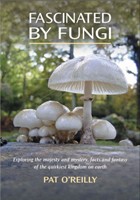Lactarius repraesentaneus Britzelm. - Yellow Bearded Milkcap
Phylum: Basidiomycota - Class: Agaricomycetes - Order: Russulales - Family: Russulaceae
Distribution - Taxonomic History - Etymology - Identification - Toxicity - Reference Sources
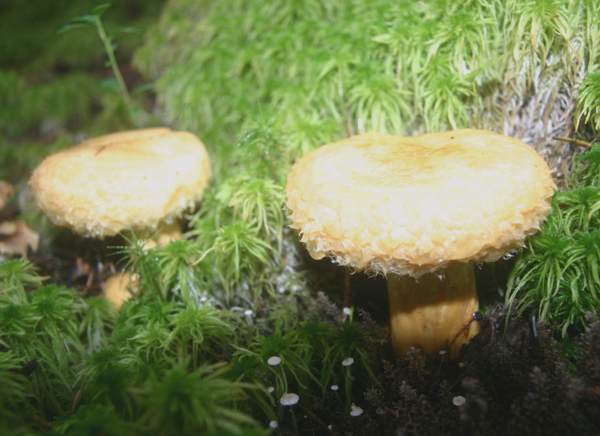
This remarkable, yellow woolly-fringed mushroom is readily identifiable by its overall appearance. Indeed, because any damaged parts quickly turn lilac or pale purple as the exuded latex changes colour upon contact with the air, there really is no excuse for mistaking it for any other species.
Distribution
The Yellow Bearded Milkcap is very rare in Britain and mostly seen in Scotland. It occurs also on mainland Europe and in North America.
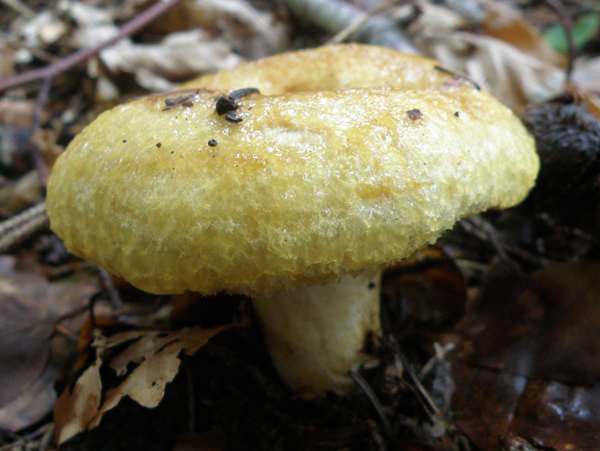
In Britain this mushroom is so rare that in the Red Data List compiled by Shelley Evans et al. in 2006 its conservation status was assessed as Near Threatened.
The pictures shown on this page was taken in a spruce forest near Lake Vernon in central Sweden during mid August.
Taxonomic history
The Yellow Bearded Milkcap was first described in 1885 by German mycologist Max Britzelmayr (1939 - 1909), who gave it the binomial scientific name Lactarius repraesentaneus by which it is generally referred to today. The scientific specific epithet is (incorrectly) spelt representaneus in some field guides.
The only synonym of Lactarius repraesentaneus that I am aware of is Lactarius scrobiculatus var. repraesentaneus (Britzelm.) Killerm.
Toxicity
Although it is unlikely to cause death or long-term illness, this is a poisonous mushroom. Yellow Bearded Milkcaps are rare and so should not be collected except for essential scientific study. These toxic toadstools should definitely not be gathered for eating because they can cause unpleasant stomach pains, sickness and a burning sensation in the throat.
Etymology
The generic name Lactarius means producing milk (lactating) - a reference to the milky latex that is exuded from the gills of milkcap fungi when they are cut or torn. The specific epithet repraesentaneus comes from Latin and means 'representative' - of the genus Lactarius in this instance. (In North America Lactarius repraesentaneus is called the Northern Bearded Milk Cap; in French it is Lactaire Représentatif.)
Identification guide
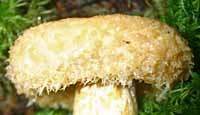 |
CapMid to dark yellow, usually without concentric colour zones; slimy in centre, but increasingly woolly towards the rim, which is overhung by ragged woolly strands; convex, flattening with an incurved margin and sometimes becoming slightly depressed; 5 to 18cm in diameter. The cap flesh is white, turning lilac when cut. |
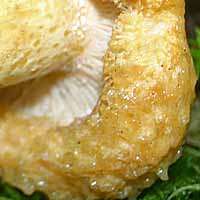 |
GillsThe adnate or shortly decurrent, crowded whitish gills eventually turn yellow or pale orange; when damaged they become stained by a copious creamy white latex that turns lilacious or pale purple when it dries. |
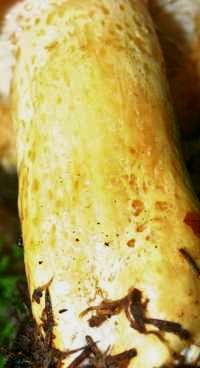 |
Stem5 to 12 cm long and 2 to 4cm in diameter; cylindrical or slightly clavate; slimy when fresh. The stem surface yellowish, usually with a few ochre-coloured surface hollows known as scrobicules (most noticeable towards the apex of the stem shown on the left); turning lilac to pale purple if bruised or cut. As with other members of the family Russulaceae, there is no stem ring. |
SporesBroadly ellipsoidal, 9-11 x 7.5-9µm; ornamented with low (<0.8µm) warts joined by ridges that do not form a complete reticulum. Spore printPale ivory. |
|
Odour/taste |
Slight fragrant odour when young; taste initially mild then usually becoming bitter and acrid. |
Habitat & Ecological role |
Mycorrhizal, singly or in small scattered groups under spruce trees. |
Season |
August to October in Britain; from late July to October in Scandinavia. |
Similar species |
Lactarius scrobiculatus produces latex that does not turn lilac but turns yellow, its spores are smaller. This very rare milkcap has not been recorded in Britain for many years. Lactarius torminosus has a pale pink to pinkish-orange woolly cap and grows under birches usually in damp soil. Lactarius pubescens has a buff-white or cream woolly cap and grows mainly in damp grass under birch trees. |
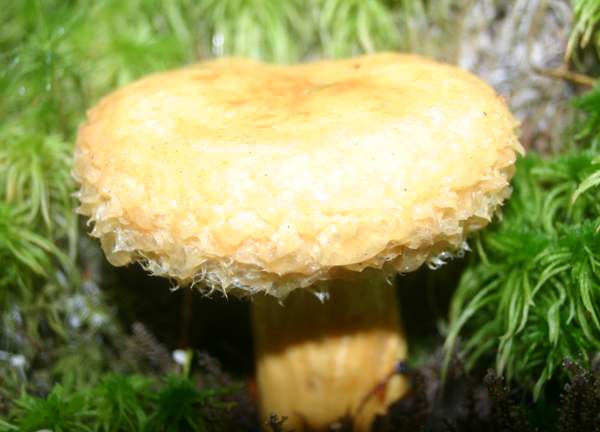
Reference Sources
Fascinated by Fungi, 2nd Edition, Pat O'Reilly 2016, reprinted by Coch-y-bonddu Books in 2022.
Funga Nordica, Henning Knudsen and Jan Vesterholt, 2008.
Fungi of Switzerland, volume 6: Russulaceae, Kränzlin, F.
BMS List of English Names for Fungi.
Dictionary of the Fungi; Paul M. Kirk, Paul F. Cannon, David W. Minter and J. A. Stalpers; CABI, 2008
Taxonomic history and synonym information on these pages is drawn from many sources but in particular from the British Mycological Society's GB Checklist of Fungi.
Fascinated by Fungi. Back by popular demand, Pat O'Reilly's best-selling 450-page hardback book is available now. The latest second edition was republished with a sparkling new cover design in September 2022 by Coch-y-Bonddu Books. Full details and copies are available from the publisher's online bookshop...
